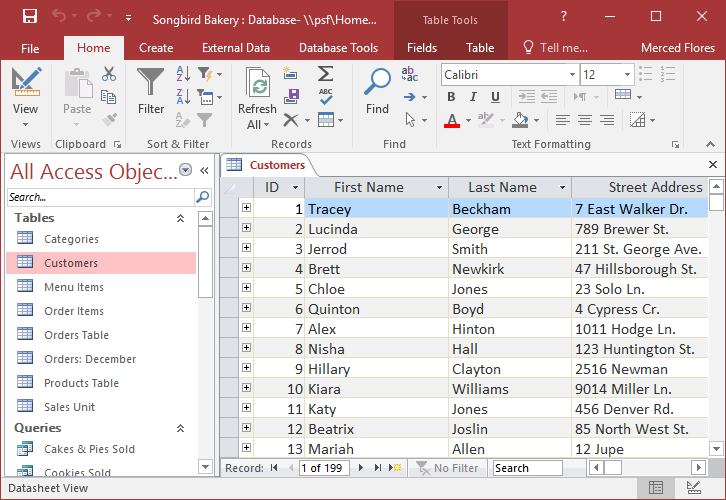Working with Tables in Access 2016: Mastering the Backbone of Database Management

Tables serve as the fundamental building blocks of any database in Microsoft Access 2016, providing a structured framework for storing, organizing, and managing data. Whether you’re tracking inventory, managing customer information, or analyzing research data, understanding how to work with tables is essential for harnessing the full potential of Access 2016. In this extensive guide, we’ll delve deep into the intricacies of working with tables in Access 2016, covering everything from table creation to data manipulation and beyond.
Understanding Tables in Access 2016
Before diving into the specifics of working with tables, it’s crucial to grasp the concept of tables in Access 2016. Tables are the foundation of any database, consisting of rows and columns where data is stored. Each column represents a field, while each row represents a record. Tables can hold a wide range of information, from simple lists to complex datasets, making them an essential component of database management in Access 2016.
Creating Tables
Creating a new table in Access 2016 is a straightforward process, thanks to the intuitive interface and powerful design tools. To create a new table, users can follow these steps:
- Navigate to the Tables Tab: Launch Access 2016 and open the database in which you want to create the table. Navigate to the “Tables” tab in the Ribbon at the top of the screen.
- Select the Table Design Button: Click on the “Table Design” button to open the Table Design view, where you can define the structure of your table.
- Define Field Names and Data Types: In the Table Design view, users can define field names, data types, and other properties for each field in the table. Field names should be descriptive and reflect the type of data they will contain, while data types specify the kind of data that can be stored in each field (e.g., text, number, date/time).
- Set Primary Key: Designate a primary key for the table, which uniquely identifies each record. The primary key ensures data integrity and facilitates the creation of relationships between tables.
- Save the Table: Once the table design is complete, save the table by clicking on the “Save” button in the Ribbon. Provide a name for the table and click “OK” to save it to the database.
Modifying Tables
In addition to creating new tables, Access 2016 allows users to modify existing tables to accommodate changes in data requirements or organizational needs. Users can add, delete, or modify fields in a table, as well as adjust field properties and set validation rules. To modify a table, users can follow these steps:
- Open the Table in Design View: Navigate to the Tables tab, select the table you want to modify, and click on the “Design View” button to open the table in Design View.
- Make Changes to Table Structure: In Design View, users can add new fields by entering field names and data types in the empty rows below the existing fields. To delete a field, simply select the field and press the “Delete” key. Users can also modify field properties by selecting the field and adjusting the properties in the lower section of the Design View.
- Save Changes: Once the desired changes have been made, save the table by clicking on the “Save” button in the Ribbon. Access 2016 will prompt users to confirm the changes before saving the table.
Importing and Exporting Data
Access 2016 offers tools for importing data from external sources, such as Excel spreadsheets, CSV files, and other databases, into tables. Similarly, users can export data from tables to external files or databases for analysis, sharing, or backup purposes. To import or export data, users can follow these steps:
- Navigate to the External Data Tab: Click on the “External Data” tab in the Ribbon to access the import and export tools.
- Select Import or Export Option: Choose whether you want to import data into Access or export data from Access to an external file or database. Follow the prompts to select the source or destination and specify any additional options or settings.
- Complete the Import or Export Process: Once the import or export settings have been configured, click “OK” to begin the process. Access 2016 will import or export the data according to the specified parameters, providing feedback and notifications as needed.
Data Validation and Integrity
Ensuring data integrity is crucial in any database management system, and Access 2016 offers tools for validating data and enforcing integrity constraints within tables. Users can set validation rules to ensure that data entered into specific fields meets certain criteria, such as data type, format, or range. Additionally, users can define relationships between tables to maintain referential integrity and prevent data inconsistencies.
Indexing for Performance
Access 2016 allows users to create indexes on fields within tables to improve query performance and data retrieval speed. Indexes help Access locate and retrieve data more efficiently by creating a sorted list of values for the indexed field. Users can create indexes on single fields or combinations of fields to optimize performance based on specific query patterns and usage scenarios.
Conclusion
Working with tables in Access 2016 is a fundamental aspect of database management, enabling users to create, organize, and manipulate data with ease and efficiency. By mastering the tools and techniques outlined in this guide, users can harness the full potential of tables in Access 2016 to build robust and reliable databases that meet their specific needs and objectives. Whether you’re a beginner or an experienced user, understanding how to work with tables is essential for success in the world of database management.




